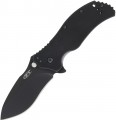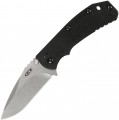Anti-glare blade coating
The presence of an
anti-glare coating on the knife blade. The most popular color for such blades is black, but there are other options, including even white. The main purpose is to prevent glare from the blade that can reveal the knife's owner or create inconvenience during use. This is especially important during hunting and similar activities, which is why this feature is often found in hunting and fishing models (see "Type") as well as "survival" knives. At the same time, it doesn't stop there. For example, matte coating is also used in
multitools, and here it primarily concerns convenience during work. In some knives, such blades play more of an aesthetic role, giving the product a stylish appearance or resembling a military model.
Blade length
The total length of the knife blade. This characteristic is one of the most important, with several practical points associated with it.
Firstly, the length of the blade is directly determined by the purpose of the product, and even within the same type (see above) there may be different options. For example, hunting knives for skinning (skinners) are usually quite short, up to 10 cm - in contrast to general-purpose options. Therefore, it is worth choosing a model according to this parameter, taking into account the work for which you plan to use the knife.
Secondly, the dimensions of the blade determine the overall dimensions of the knife itself. This is especially important for outdoor models (see "Type"): although the knife is usually worn folded, it is customary to indicate its dimensions in the specifications for the unfolded position. And by the length of the blade, you can quite clearly estimate the length of the knife when folded: usually it is 1.5 - 1.7 times longer than that of the blade itself, and in any case, the knife cannot be shorter than its own blade.
Thirdly, the length of the blade can be (and in many CIS countries is) one of the criteria for determining whether a knife belongs to a cold weapon. Usually, regulatory documents indicate a certain minimum length value: shorter blades do not fall into the category of edged weapons, regardless of their design, and for longer blades, specific evaluation criteria come into force...(hardness of the material, shape of the point, blade thickness, etc.).
At the same time, it should be borne in mind that the length of the blade can be measured in different ways: from the point to the beginning of the handle, from the point to the peg used in opening, etc. In practical application, this moment does not play a decisive role, however, it can create legal problems: for example, state examination methods may not take into account the peg. So, if you have doubts about this, it is best to purchase a knife that has an official certificate that this model is not a melee weapon.
Handle material
The material from which the knife handle is made. For models with handles with overlays, in this case, it is usually the material of the overlays that is indicated.
The list of the most popular modern materials includes
plastic,
micarta,
rubber,
fiberglass,
CFRP,
wood,
metal, in particular
aluminium,
steel,
titanium,
brass . There are other, more specific options, such as
animal bone or horn.Here are the main features of different materials:
— Plastic. Plastic is often associated with cheap products, but in the case of knives, things are ambiguous. The fact is that there are many varieties of this material on the market, including very high quality, and the real properties of the plastic handle depend primarily on the price category of the knife. At the same time, some features are common to all variants. On the one hand, plastic in general is quite inexpensive, while being easy to process, it can easily take on complex shapes and almost any colour shade. In addition, it is relatively light, resistant to water and quite durable. Among the disadvantag
...es: most types of plastic are inferior to metals in reliability and can crack from a strong impact, and this material scratches much easier.
— Fiberglass. Most often, this term does not mean pure fiberglass (it is not suitable for making handles), but fibre-reinforced plastic — a composite material that combines glass fiber and a binder polymer. This material is lightweight, resistant to water and temperature changes and very durable — its most advanced varieties are not inferior to steel. Like ordinary plastic, it is well suited for creating complex shapes. Another advantage of fiberglass is low thermal conductivity — in other words, such a handle does not “cool” the hand much in the cold. However the price of all these advantages is quite high.
— Wood. This material has been used for knife handles for a long time, but does not lose popularity today. Many appreciate wood for its pleasant and stylish appearance, but its advantages are not limited to this: wooden handles are relatively light, pleasant to the touch, including and in cold weather, and also do not slip out of the hand. On the other hand, a wood that does not receive a special treatment tends to accumulate moisture, which leads to loss of "presentation" and even damage; in addition, this material is quite sensitive to cracks and scratches. It is worth saying that different types of wood can be used in knife handles, including those that are devoid of the shortcomings described above — but they usually weigh a lot and are very expensive. Relatively simple options can be quite expensive.
— Rubber. Classical rubber is well suited for kitchen knives, but is poorly suitable for camping and other similar models due to softness, and therefore is rare. Specific types of rubber are more commonly used; their properties are usually largely similar to the plastic described above.
— Steel. One of the most popular materials for multi-tools, where the handles are subjected to significant stress; however, it is also found in knives. The key advantages of steel are high strength and reliability. It has a rather large weight, but massiveness often also turns out to be a virtue — in particular, it creates an additional impression of strength and reliability. Among the unequivocal disadvantages of steel, one can note the tendency to “cool” fingers and slip out of wet hands; however, the first moment is noticeable only in cold weather without gloves, and the second is often compensated by a relief notch, which provides additional security in holding. It is also worth considering that different grades of steel may have different resistance to corrosion, some varieties may require additional care.
— Aluminium. Another material that is quite popular among multitools, but also used in knives. In many respects it is similar to steel, however, on the one hand, it weighs less and is more resistant to corrosion, on the other hand, it costs more.
— Mikarta. Material from the family of textolites; A “layered” composite that combines a fibrous material (such as paper, fabric, or fiberglass) with a polymeric filler. The specific composition of micarta may vary, but high-pressure sintering is a mandatory feature of production. Thanks to this, the material is very dense, durable and reliable, it is suitable even for top-class knives, and the low-cost allows the use of micarta in low-cost models. On the practical side, micarta is quite pleasant to the touch, absolutely insensitive to water and temperature changes, does not cool the hand and does not conduct electricity. In addition, micarta handles also look good: for example, many of them have characteristic patterns that mimic the texture of wood.
— Titanium. Titanium-based alloys can be classified as premium materials. In addition to a solid appearance, they have low weight combined with high strength. In addition, titanium handles are well suited for use at low temperatures due to their low thermal conductivity. The main disadvantage, traditionally for such materials, is the high cost.
— CFRP. Composite material combining carbon fiber threads (carbon) and a plastic base. The main advantage of this material is its high strength, comparable to that of steel — despite the fact that it weighs much less, besides, it is absolutely not subject to corrosion. On the other hand, carbon fiber does not tolerate point impacts well — cracks can appear from this; and the cost of such handles is very high.
— Animal horn. Natural horn (for example, deer or bull) is one of the traditional materials used for knife handles for a long time. The main advantages of this material are an aesthetic appearance with a characteristic pattern, as well as a relief texture that makes it easier to hold the knife in your hand. In addition, low thermal conductivity contributes to the comfort of holding, due to which the handle does not cool the hand. On the other hand, the horn is less durable than the same steel or fiberglass. Therefore, nowadays, this material is used mainly for aesthetic reasons — to give the knife a characteristic style.
— Bone. Another "traditional" material, in many respects similar to the horn described above — in particular, the bone is pleasant to the touch and looks stylish in "hunting" knives, but in terms of strength it is somewhat inferior to more modern materials. The main difference from the horn is that bone handles have more variations in texture and colour, and their surfaces are usually smooth; the latter can be both a disadvantage and an advantage, depending on the preferences of the user.
— Leather. Leather overlays on the handle not only give the knife a stylish appearance, but also provide quite practical advantages: such a surface is reliable when held both with bare hands and with gloves, it does not cool hands and is pleasant to the touch. On the other hand, such a design is quite expensive and does not have clear advantages over simpler materials. Therefore, leather is used mainly as an element of external design, and not for practical reasons.
— Bronze. An alloy based on copper, usually with tin, having a peculiar colour (reddish or golden). In terms of basic properties, it is similar to steel (see above), on the practical side it differs only in its original appearance and higher cost. Therefore, bronze is rarely used, mainly to give the knife an original appearance.
— Brass. An alloy based on copper and zinc, with a characteristic golden colour. It is similar in characteristics and application to the bronze described above, it is used more for aesthetic rather than practical reasons.
— Metal. This option is indicated for models in which the manufacturer, for one reason or another, did not specify the specific composition of the metal used for the handle (steel, aluminium, bronze, etc.), as well as for handles consisting of unusual alloys that are not related to any one of the options above. The specific properties of the "metal" may be different, it is easiest to evaluate them by the price category of the knife.Weight
The total weight of the knife. It is worth evaluating this indicator depending on the type (see above) and purpose: for example, for a compact hiking model,
light weight is usually a virtue, among hunting and fishing it all depends on specialization, and a machete, by definition, must be
weighty — otherwise, cut with such a blade it will just be uncomfortable.

